- About
- Programs
- Issues
- Academic Freedom
- Political Attacks on Higher Education
- Resources on Collective Bargaining
- Shared Governance
- Campus Protests
- Faculty Compensation
- Racial Justice
- Diversity in Higher Ed
- Financial Crisis
- Privatization and OPMs
- Contingent Faculty Positions
- Tenure
- Workplace Issues
- Gender and Sexuality in Higher Ed
- Targeted Harassment
- Intellectual Property & Copyright
- Civility
- The Family and Medical Leave Act
- Pregnancy in the Academy
- Publications
- Data
- News
- Membership
- Chapters
The 2021 AAUP Shared Governance Survey: Findings on Demographics of Senate Chairs and Governance Structures
New survey data on the present state of governance.
The 2021 AAUP Shared Governance Survey, the first such national survey in two decades, covered a wide range of topics related to academic governance. I reported on responses to survey questions about the impact of the COVID-19 pandemic on governance and the relative authority of the faculty in various areas of academic decision-making in an online data snapshot titled “Survey Data on the Impact of the Pandemic on Shared Governance” and in the report Findings on Faculty Roles by Decision-Making Areas, respectively. This report focuses on responses to questions about the composition of senates and similar faculty governance bodies, faculty-board communication, and the conduct of presidential searches as well as questions about the demographic composition and professional characteristics of faculty governance leaders. I present the results by institutional control (public or private nonprofit); by Carnegie classification (distinguishing broadly between doctoral, master’s, and bachelor’s institutions); by institutional size, with institutions categorized as “small” (fewer than two thousand students), “medium” (between two thousand and five thousand students), or “large” (more than five thousand students); and by the collective bargaining status of tenured and tenure-track faculty members (at institutions with a tenure system) or full-time faculty members (at institutions without a tenure system). When possible, I also compare findings with results from previous national surveys on shared governance conducted or sponsored by the AAUP.
Characteristics of Governance Leaders
The AAUP’s Department of Research selected respondents for the 2021 AAUP Shared Governance Survey based on their roles as senate chairs or faculty governance leaders in similar positions at sampled institutions, a common practice in organizational surveys. Most questions concerned governance structures and practices, but the survey also asked respondents to provide information about themselves in order to collect data about the demographic composition and professional characteristics of senate leaders as a group.
Nearly all senate chairs and other faculty governance leaders are full-time faculty members: 99.1 percent reported being full-time and only 0.9 percent reported being part-time. Governance leaders are also predominantly from the higher faculty ranks: 53.6 percent reported being full professors, 32.5 percent reported being associate professors, 8.5 percent reported being assistant professors, and 5.4 percent reported being another rank, such as lecturer or instructor. The overwhelming majority of governance leaders at institutions with a tenure system are tenured (90.7 percent), with only 4.5 percent of respondents reporting being on the tenure track but not yet tenured and just 4.8 percent reporting being non-tenure-track faculty members.
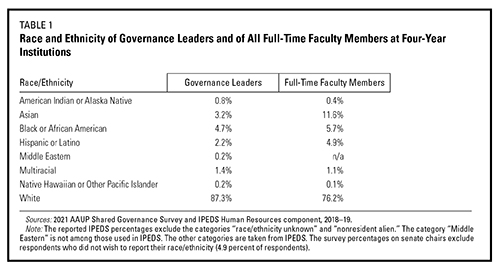
Table 1 compares the demographics of senate chairs and other faculty governance leaders with corresponding data on full-time faculty members at four-year institutions from the Integrated Postsecondary Education Data System (IPEDS). This comparison shows that white faculty members are overrepresented among senate chairs relative to full-time faculty members as a whole: 87.3 percent of survey respondents reported being white, compared with 76.2 percent of all full-time faculty members at four-year institutions, a difference of 11.1 percentage points. Asian and Hispanic faculty members, in particular, are underrepresented among governance leaders by 8.4 percentage points and 2.7 percentage points, respectively.
In addition to the specific question about the race or ethnicity of the respondent, the survey asked more generally whether a governance body exists at the institution that addresses issues of equity and inclusion, such as a diversity, equity, and inclusion committee or a diversity caucus. Overall, 62.4 percent of respondents reported that their institution had such a committee—77.0 percent of respondents at doctoral institutions, 60.5 percent of respondents at master’s institutions, and 51.4 percent of respondents at bachelor’s institutions. Among respondents who reported their gender identification, 43.1 percent identified as women and 56.9 percent as men. The corresponding percentages in IPEDS among full-time faculty members at four-year institutions are 45.6 percent women and 54.4 percent men. The AAUP questionnaire, unlike the IPEDS survey, allowed for responses of “nonbinary” and “other,” which no respondents chose; 3.4 percent declined to identify their gender.
One other survey item asked whether, in the last three years, the chair of the senate or faculty council had moved to an administrative position. The purpose of this question was to track the extent to which leadership on faculty governance bodies serves as an entry point to an administrative career. Overall, 18 percent reported that such movement had occurred, with 82 percent reporting either that it had not or that they did not know if it had. The findings varied by Carnegie classification: among doctoral institutions 22.3 percent of respondents reported that faculty governance leaders had moved to administration, compared with 17.5 percent among master’s institutions and 14.8 percent among bachelor’s institutions.
Composition of Senates and Councils
The Statement on Government of Colleges and Universities recommends that “an agency should exist for the presentation of the views of the whole faculty.” At some institutions, especially smaller ones, this agency may simply be a plenary faculty meeting, but senates or councils serve this function at many other institutions. A 2001 shared governance survey sponsored by the AAUP found that 74.8 percent of four-year institutions had a senate or council; by 2021, that figure had increased to 89.3 percent. The prevalence of institutions with a senate or council differs by Carnegie classification, with 97.0 percent of doctoral institutions, 92.3 percent of master’s institutions, and 78.2 percent of bachelor’s institutions having such a body. Most of the findings reported below apply only to those institutions that have a senate or a council. Questions concerning the composition of senates cover different aspects of those bodies, including the mechanism for selecting faculty representatives; the membership of administrators, staff, or students; and the participation of faculty members on contingent appointments.
The survey included separate questions about mechanisms for selecting faculty representatives to the senate or council and to other institutional committees, task forces, and administrative search committees. The Statement on Government provides that “faculty representatives should be selected by the faculty according to procedures determined by the faculty.” At 87.5 percent of institutions with a senate or a council, the faculty elects all faculty representatives serving on the senate or the council; at 8.4 percent of institutions, the faculty elects only some of its representatives; and at 4.1 percent of institutions, it elects none. The percentage of institutions reporting that none of the faculty representatives on the senate or council is elected by the faculty differs by Carnegie classification: at bachelor’s institutions, 9.3 percent report that none of the representatives is elected, compared with 2.7 percent at doctoral and 1.8 percent at master’s institutions.
The survey question concerning the method of selection of faculty representatives to institutional committees, task forces, and administrative search committees provided a broader range of response choices, reflecting the diversity of practices in such bodies. The faculty elects all representatives at 14.7 percent of institutions, elects most of them at 39.4 percent of institutions, and elects about half at 21.5 percent of institutions; the administration appoints most faculty representatives at 21.6 percent of institutions and appoints all faculty representatives at 4.1 percent of institutions. The survey responses showed little variation between different types of institutions. Because such committees exist at institutions without senates or councils, the results for this survey item include responses from those institutions.
The survey also asked about the membership and voting rights of administrators, students, and staff on senates and faculty councils. Administrators hold membership with vote on senates and councils at 18.6 percent of institutions and membership without vote at 50.0 percent of institutions. Staff hold membership with vote at 15.4 percent of institutions and membership without vote at 11.7 percent of institutions. Undergraduate students hold senate or council membership with vote at 14.6 percent of institutions and without vote at 22.2 percent of institutions. Among universities that have graduate programs, graduate students have voting membership on senates and councils at 9.7 percent of institutions and nonvoting membership at 7.0 percent of institutions.
The AAUP has inquired about which groups of faculty members can participate in governance since conducting its first governance survey in 1920, when the prevailing tenure system put the focus on faculty ranks (particularly on whether instructors and assistant professors were “members of the general faculty” who could vote in plenary faculty meetings at a time when senates were rare). Given the changes that occurred in the rank and tenure system since then, as well as the expansion of governance rights to the lower ranks, the AAUP’s 1971 governance survey assumed that all full-time faculty members at responding institutions could participate in governance and did not specifically ask about participation on the basis of faculty rank or status.
The 2001 governance survey, reflecting changes that had occurred over the previous three decades, reported that 19.9 percent of institutions restricted voting rights in governance based on rank or tenure status (with 17.0 percent reporting that only tenured or tenure-track faculty members could vote); 57.9 percent of institutions restricted voting rights based on full-time status; and 2.6 percent of institutions restricted voting rights based on bargaining-unit membership. All instructional faculty members (including part-time faculty members) had voting rights in governance at 19.6 percent of institutions.
In 2012, the Association published The Inclusion in Governance of Faculty Members Holding Contingent Appointments, a report that recommended extending the opportunity to participate in governance to all full-time and part-time faculty members on contingent appointments. As that report notes, participation can take the form of voting in elections for senate or council representatives or serving as a representative (in addition to other forms of participation, including at the departmental level). The opportunities for such participation, however, may not be the same across all institutions. For that reason, the 2021 shared governance survey covered the two aspects of contingent faculty participation separately. Further complicating matters, many institutions distinguish between different groups of non-tenure-track faculty members, such as professors of teaching who may have ranks (assistant, associate, full), lecturers, or postdoctoral fellows. At some institutions, the eligibility of faculty members on contingent appointments to participate in governance is not the same across all groups. Since systems of classifying various types of faculty members on contingent appointments lack standardization across institutions, the 2021 survey did not attempt to determine which groups of faculty could participate in governance at each institution. For each of the two groups (full-time contingent and part-time faculty members), the questionnaire asked whether all, some, or no members of the group could vote or serve on the senate or council.
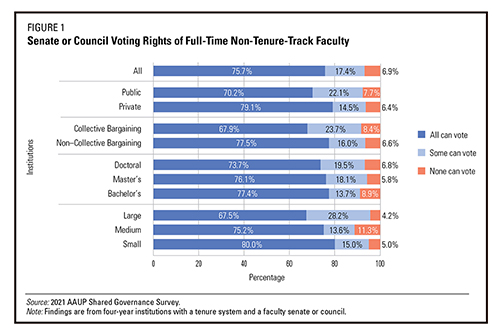
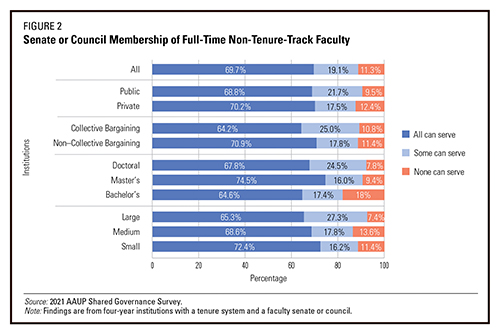
At 75.6 percent of four-year institutions that have a senate or council, all full-time faculty members on contingent appointments can vote in elections, and at 69.7 percent of four-year institutions, these faculty members can serve on the senate or the council. At 17.4 percent of these institutions, only some contingent faculty members can vote, and at 19.1 percent, only some can serve on governance bodies (figures 1 and 2). Just 6.9 percent of institutions do not allow any full-time faculty members on contingent appointments to vote in senate or council elections, and 11.3 percent of institutions do not allow any of them to serve. The percentage of institutions at which respondents reported that only tenured or tenure-track faculty members could vote has fallen from 17.0 percent in 2001 to 6.9 percent by 2021, suggesting that policies supporting the participation of contingent faculty members in governance have become more widely adopted.
Two differences by Carnegie classification stand out in this year’s survey findings on contingent faculty members. First, among bachelor’s institutions, a wide gap exists between the ability to vote and the ability to serve for full-time faculty members on contingent appointments, with 91.1 percent of institutions providing some or all of these faculty members with the right to vote in elections but only 82.0 percent providing them with the right to serve on faculty senates or councils, a difference of 9.1 percentage points. Second, public, large, and doctoral institutions, as well as institutions at which the faculty bargain collectively, are more likely to restrict both voting rights and service on a senate or council to certain groups of full-time faculty members on contingent appointments—likely a reflection of the wider variety of full-time contingent appointment types at these institutions.
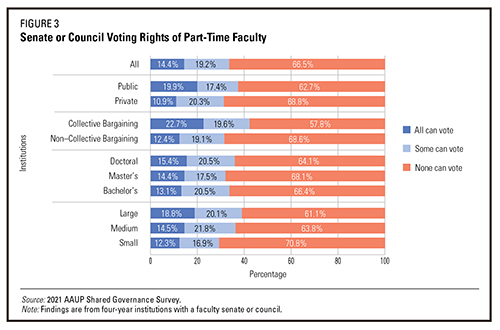
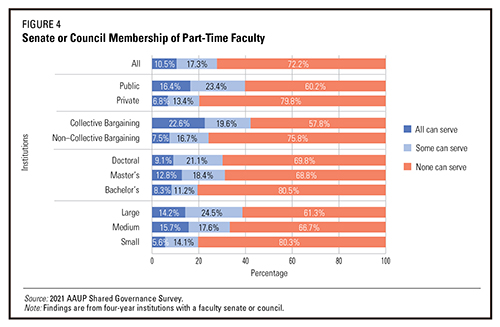
At 66.5 percent of all institutions (both with and without tenure systems), part-time faculty members cannot vote, and at 72.2 percent they cannot serve on senates or councils (figures 3 and 4). Some groups of part-time faculty members can vote at 19.2 percent of institutions, and some can serve at 17.3 percent of institutions; all part-time faculty members are allowed to vote at 14.4 percent of institutions and to serve at 10.5 percent. Compared with 2001, the percentage of institutions allowing all part-time faculty members to vote in elections has declined somewhat, from 19.6 percent to 14.4 percent. This change may be partly explained by the overall growth in the percentage of institutions that have a senate or a council, since some newly created faculty governance bodies may not have provided for full participation of part-time faculty members. The questionnaire did not ask whether institutions had made changes to the eligibility of faculty groups to participate in governance during the past two decades.
Private, small, and bachelor’s institutions provide the least opportunity for part-time faculty members to participate in governance, with respondents in each case reporting that around 70 percent do not allow any part-time faculty members to vote and around 80 percent do not allow any to serve. Part-time faculty members were most likely to be able to vote and to serve (both at rates of around 22 percent) at institutions where the full-time faculty was unionized. As with full-time faculty members on contingent appointments, public, large, and doctoral institutions are more likely to provide only some groups of part-time faculty members with the right to vote and to serve.
Faculties, Boards, and Administrations
The previous report on results from the 2021 AAUP Shared Governance Survey, Findings on Faculty Roles by Decision-Making Areas, focused on the relative authority of the faculty and the administration in institutional decision-making. The report acknowledged the participation of the governing board in institutional governance but noted that, in the areas of decision-making surveyed, faculty governance bodies tend to interact with the administration as the representative of the board rather than with the board directly. However, faculty members interact with governing boards in a variety of ways, including through joint membership on presidential search committees, various modes of faculty-board communication, and full (that is, with voting rights) membership of faculty members on governing boards. A separate set of questions asked about forms of faculty-board communication as well as the conduct of presidential searches.
The AAUP has long held that faculty should participate meaningfully in the selection of the president. According to the Statement on Government, “Joint effort of a most critical kind must be taken when an institution chooses a new president. The selection of a chief administrative officer should follow upon a cooperative search by the governing board and the faculty, taking into consideration the opinions of others who are appropriately interested.” The AAUP statement Faculty Participation in the Selection, Evaluation, and Retention of Administrators, most recently revised in 1981, suggested multiple ways in which a “cooperative search” could be organized, and by the time of the 2001 governance survey, 94 percent of institutions reported that faculty had served as members of the most recent presidential search committee. Thus, by that time, faculty membership on presidential search committees was clearly the almost universally accepted form of faculty participation.
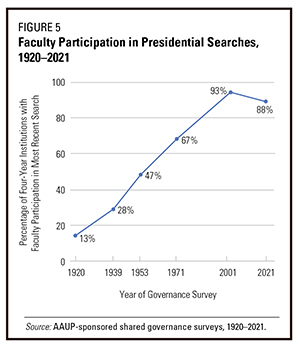
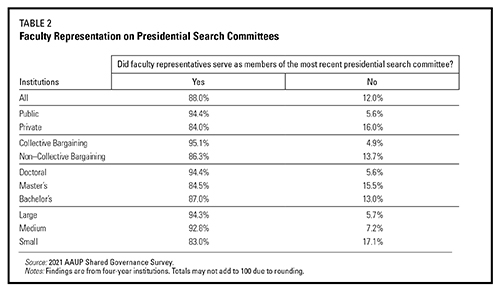
In the 2021 survey, 88.0 percent of institutions reported that faculty representatives served as members of the most recent presidential search committee (table 2). Faculty membership on presidential search committees was less prevalent at small (83.0 percent), master’s (84.5 percent), and bachelor’s institutions (87.0 percent). The percentage of faculty membership was higher at doctoral (94.4) and large (94.3 percent) institutions, as well as at institutions at which the faculty is unionized (95.1 percent). Figure 5 compares the development of faculty participation in presidential searches since 1920; this year’s finding represents the first decline in faculty participation in a century, although, given the margin of error, the decline may in fact be smaller.
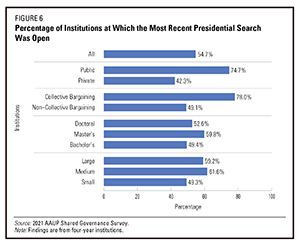
In addition to emphasizing the importance of faculty participation in presidential searches as members of search committees, the AAUP recommends in its 2013 statement Confidentiality and Faculty Representation in Academic Governance that the final phase of a presidential search be “open”—that the names of finalists be announced on campus before the final selection is made. Moreover, the AAUP recommends in the same statement against the use of confidentiality or nondisclosure agreements as a precondition for faculty participation in governance, including on presidential search committees. Both closed searches and confidentiality agreements have been areas of concern raised by individual senates or AAUP chapters in recent years, although little information has been available about the prevalence of such practices. As figure 6 shows, 54.7 percent of institutions in the 2021 survey reported that the most recent presidential search was open. Large differences existed, in particular, between public and private institutions (74.7 percent versus 42.3 percent) and between institutions at which the faculty are unionized and those at which they are not (78.0 percent versus 49.1 percent). A minority of institutions (40.1 percent) reported the use of confidentiality agreements, with 59.9 percent responding that no confidentiality agreement had been used or that the respondents did not know whether one had been used.
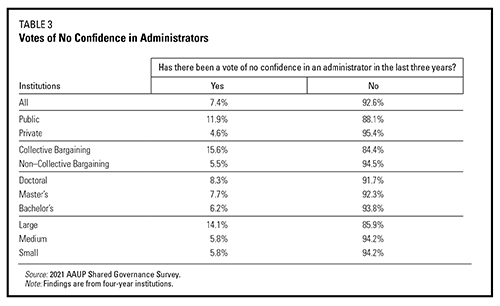
The survey also asked about the related topic of faculty participation in the evaluation of administrators. Across all institutions, 42.8 percent of institutions reported faculty participation in the review of the provost or vice president of academic affairs, 52.2 percent reported participation in the review of deans, and 54.3 percent reported participation in the review of department chairs during the last five years. While faculty participation in the evaluation of administrators represents a regular channel through which the faculty should be able to address concerns about the performance of administrators, faculties or representative faculty bodies at times resort to conducting votes of no confidence in administrative officers, especially when administrations take extraordinary actions that violate norms of governance or academic freedom. The survey asked whether, in the last three years, the faculty or the senate had taken such a vote regarding any administrative officer, and 7.4 percent of respondents reported such an action as having occurred. Marked differences existed between public and private institutions, between institutions with and without faculty unions, and between large institutions, on the one hand, and small and medium institutions, on the other (table 3).
The AAUP recommends that faculty-board communication occur regularly. As the Statement on Government observes, such communication can take place through voting membership of faculty representatives on the governing board or through a joint conference or liaison committee; the recent AAUP statement Faculty Communication with Governing Boards: Best Practices recommended the latter.
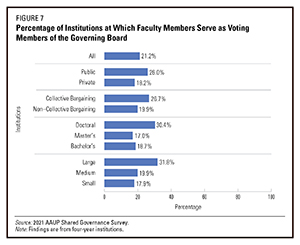
The 2021 survey found that 21.2 percent of institutions have voting faculty representatives on their governing boards (figure 7), with a difference of 8 percentage points between public (26.1 percent) and private (18.2 percent) institutions. A 2016 study by the Association of Governing Boards of Universities and Colleges (AGB), Policies, Practices, and Composition of Governing Boards and Foundation Boards, reported that 10.9 percent of public governing boards and 15.4 percent of private boards have voting faculty representatives. These seemingly disparate findings may be partly explained by the fact that the AGB’s study included public boards at two-year institutions, while the AAUP survey did not; faculty representation on governing boards may be less prevalent at two-year institutions. Moreover, it is important to stress that the AAUP’s survey focused on the institutional level, reporting the percentage of institutions that have voting faculty representatives on their respective governing boards, whereas the AGB’s study reported the percentage of governing boards with voting faculty representatives. Some boards, especially in the public sector, govern multiple institutions, which may further explain the discrepancy between the findings reported here and those reported by the AGB. Overall, 63.5 percent of institutions in this survey have a formal mechanism for direct communication between the faculty and the governing board, with little variation by institutional type.
Conclusion
This report has focused on findings of the 2021 AAUP Shared Governance Survey related to structural aspects of governance and the demographics of governance leaders. As in the earlier report on the relative authority of faculty and administration in institutional decision-making, the overall picture for shared governance that emerges from the survey’s findings is mixed.
On the one hand, results in some areas show positive developments since 2001. The percentage of institutions that have a senate or council has increased some 15 percentage points, to about 90 percent of institutions, and the prevalence of institutions that restrict governance rights to tenured or tenure-track faculty members has declined by some 10 percentage points, to about 7 percent of institutions. Almost two-thirds of institutions reported having a formal mechanism for direct faculty communication with the governing board, such as through the senate or a joint conference committee.
On the other hand, the percentage of institutions that allow for full governance participation of all part-time faculty members has declined by some 5 percentage points since 2001. Faculty participation in presidential searches has also declined, from 94 percent to 88 percent, a finding that underscores ongoing concerns about the conduct of such searches. Both the prevalence of open searches and the use of confidentiality agreements have not been sufficiently studied in the past, and they should both be measured in the future in order to track their development.
Findings related to the demographics of senate chairs show that, as a group, they are overwhelmingly full-time faculty members at the higher ranks and, at tenure-granting institutions, have tenure. Compared with the overall racial and ethnic composition of full-time faculty members at four-year institutions, white faculty members are overrepresented, and Asian faculty members, especially, are underrepresented among faculty governance leaders.
Technical Note
The population to which the results of this study are intended to be generalized and from which the sample was drawn consists of 1,422 public and private nonprofit institutions of higher education that are classified as bachelor’s, master’s, or doctoral institutions in the Carnegie classification system. The AAUP’s Department of Research sent the questionnaire to senate chairs and other similarly positioned faculty governance leaders at a stratified random sample of 585 four-year institutions. The response rate was 68 percent. The data were weighted to account for different probabilities of selection during sampling between different strata and to account for nonresponses. Estimates of proportion in the population made on the basis of a sample have a margin of sampling error that depends on the sampling design, the size of the sample, and the estimated proportion itself. With 396 respondents in this stratified sample, it is +/− 4.3 points when the proportion reported is 50 percent, which is when the margin of error is largest for a given sample size. For a fuller description of the methodological aspects of the study as well as full references to cited literature, see The 2021 AAUP Shared Governance Survey: Findings on Faculty Roles by Decision-Making Areas.
Hans-Joerg Tiede is director of research at the AAUP.



